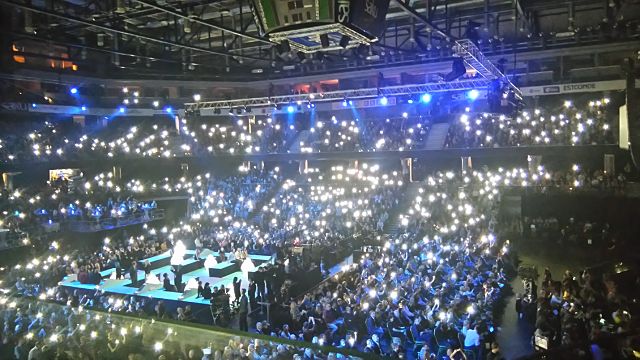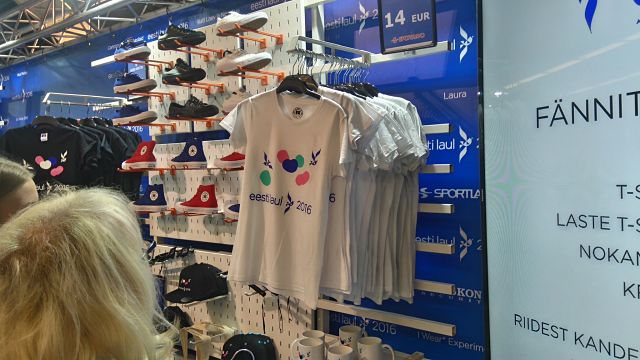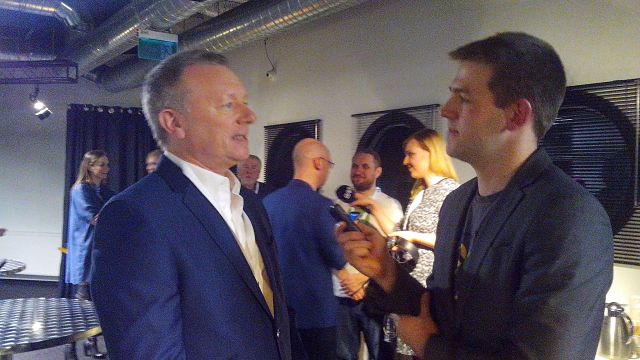The Eurovision Song Contest has always meant a big deal to Estonia. The country’s victory in 2001 provided the springboard for a political revolution and gave birth to Estonia’s economic surge. That platform the Song Contest provided Estonia was utilised to paint a picture of hope and success, it promoted a positive image on one of Europe’s smallest countries in a way we haven’t seen since.
After that victory the Contest was still undoubtedly important to Estonia, but various things aligned against the nation topping the leaderboard again. Local star attraction Vanilla Ninja ended up coerced into representing Switzerland in 2005, and qualifying where Estonia languished in 20th points in the Semi Final. Bringing in a Swedish singer for a schlager song, as was a success when hosting the Contest, flopped the year after in the face of a Carola-sized hurricane. The real low point was the selection of Kreisiraadio in 2008. The comedic trio were funny, but the joke was on them rather than with them with only eight points in the Semi Final, seven of which were from Finland.
The selection format, Eurolaul, was popular. Sadly though it was stuck in a rut of trying to find what would do well in Europe without any success.
Tinkering on the thoughts of withdrawing, instead came the addition of Eesti Laul. The message was clear, we were picking Estonia’s best song and putting it on the biggest platform we can offer. No longer was Estonia feeling a need to suck up to Europe, if it would do well it would be on its own merits. Since then Estonia has a five in seven qualification rate, with all three songs written in Estonian making it through the Semi Final hurdle. The move revitalised a local competition which turned itself away from a reject bargain bin for Eurotrash into undoubtedly Eurovision’s most alternative selection process.
Marrying Eurovision With The Local Brand
The genres of songs that feature in Eesti Laul continue to go above and beyond the wildest expectations. Whereas most countries would be content with National Finals with pop, rock, and ballads in varying proportions, perhaps spiced by an occasional nod to rap, Eesti Laul conjures up types of music each year we have never seen on the Eurovision stage before. This tradition comes from the fruits of working in a youthful, energetic nation. The former head of Eesti Laul, Heidy Purga, took over after the ‘Leto Svet’ disaster. Her contacts within the world of youth radio re-energised the competition and encouraged a new lease of life to a dying concept of ‘songs for Europe’. Now was the time for Estonian song, and some of that found life outside Estonia’s small fanbase.
This year was no different with all twenty of the songs competing in Eesti Laul written by Estonian composers. Yes they played on modern musical trends, but none of them felt like the carbon-copy three minute song we all simultaneously love and hate. Probably the only country to compete with Estonia for originality would be Finland, but whereas UMK feels quite forced for musical styles the Estonain eclecticness is purely organic and a natural part of the culture.
Meisterjaan was topping the Estonian viral Spotify charts after the show with his jew’s harp electronic hypnotica ‘Parmuphillihullus’. Laura returned for another stab at the Eurovision ticket and once again came second. Yes her song was pop, with one of those well-placed key changes, but songwriter Sven Lõhmus’ style is still worlds away from the Swedes and all the better for it. My big hit was discovering the world of Mick Pedeja, who performed the mystical ballad ‘Seis’ which possessed such a unique calmness and originality it could only appear in an Estonian selection.
It all stems from years of revival and local success, which hit the high point last year. From the very start of the twenty song shortlist all eyes and ears fell on Elina and Stig’s ‘Goodbye to Yesterday’, a timeless eight-chord loop by two of the country’s most beloved performers. It stormed to victory in Eesti Laul and was a real crossover point for the competition. For the first time since the turn of the century, Estonia was heading up the Eurovision betting odds and a buzz was being made locally about the competition.
Alas, the momentum dropped off so seventh place in Vienna was the final result. The song didn’t travel around on radio pre-contest half as much as expected (although it did get good airplay afterwards), and in the end the top three ran away with performances that had more immediate impact than the subtle single tear rolling down Elina’s right cheek. Nevertheless Eesti Laul was riding a high, and even though limits were put on how many songs each performer could enter for the 2016 edition, a record number of 238 entries were received.
Eesti Laul was going bigger than ever before, and after toying with the thought of Eurovision victory, broadcaster ERR was ready to prove to itself they could deliver.
A Bigger Home, And Another Nod To Europe
The 2015 Eesti Laul final was held in the centre of town at the Nordea Concert Hall. It’s your classic sit-down classical concert venue which certainly worked for the Estonian competition, but wasn’t quite modern Eurovision. Audience wise it felt very high society with everybody dressed up to the nines. This proved a slight problem for pop rocker Daniel Levi, who brought in a posse of his supporters to carry him from his stagedive while the front row audience behind begrudgingly stood up behind to get a view.
Eesti Laul had clearly outgrown this location, but the vision and commitment to move out of the safety of such a well known venue should be commended. The alternative was to move into the Saku Suurhall, the very arena which the Eurovision Song Contest was held in 2002. In a modern Eurovision sense, the Suurhall would be a touch on the small side with a maximum capacity of 10,000 with a standing audience. With seats and a Green Room in the middle of the arena, the numbers attending were just a little more than half this, but almost every seat was taken. The move was a success.

Audience participation was key with the floor instructed to stand up for each performance and provide more atmosphere (Photo: Ben Robertson)
One of the bigger successes of the transfer was the feel of the venue. This wasn’t just doing a concert, it was Eesti Laul and it was revolutionised into a very big deal. Gone were decadent wine lists to pour over pre show, now we had a red carpet as you entered the arena, merchandise stalls from sponsors and arena grub on offer. Indeed if you hadn’t have told me I could have swore I had entered the world of a Melodifestivalen Semi Final, and I mean that with no disrespect.
In Melodifestivalen part of the circus is that all the sponsors line up with different stalls to advertise their goods. It could be as simple as giving out free soft drinks, but some are elaborate quizzes and audience participation challenges. It’s fun. I don’t think the concourse around the arena had ever been so full with fans to-ing and fro-ing picking up their free flags of their favourite act and checking out the Eesti Laul cushions and t-shirts. The nod to Melodifestivalen here was deliberate, and I was told later in the evening that Melodifestivalen was their inspiration. Estonia had watched the competition close up with Head of Delegation Mart Normet has been spokesperson for the Estonian Melodifestivalen Jury for three consecutive years. This was a case of watching, learning, and tweaking the excitement of the Swedish bubble to a Estonian audience.

A wide range of Eesti Laul branded goods were available to buy (Photo: Ben Robertson)
Venturing inside the arena the same level of step up in production is clearly apparent. The use of the spider cam across the arena roof was precisely what Melodifestivalen has been using, and used to great effect for full arena shots. Coupling this with the use of Segways along the arena floor and cameras popping up from under the arena floor gave the show a level of detail that frankly we would gladly accept for a Eurovision Song Contest production itself.
However what was more groundbreaking for Estonia was the commitment to the staging of each act. At first I was put out by the choice to pre-record the Semi Finals for Eesti Laul, and bring all the acts into the studio for the voting segment. The reasoning to this was to dedicate time towards the visual aspects of each song, giving each of the twenty performances unique flavours. They even scheduled a two week break between the Semi Finals to the Grand Final in order to problem-solve how to produce each performance live. A particular headache would have been the animation video from band Cartoon presented with Kristel Aasleid in the lead character role. The motion capture idea was creative, detailed, and added a more compelling story to the visual narrative.
This commitment to visuals is not just a nod to Sweden’s successes, but a nod to the whole culture of Eurovision and the direct it has moved in. ERR made sure this Eesti Laul was more fit for purpose and made the acts extra ready for the type of challenge the modern Eurovision Song Contest is.
A Creative Manifesto To Bring The Contest Back
Over the last few years, the Eurovision Song Contest has been around countries that have either been rich or able to splash cash at the Song Contest. As the modern Contest became a huge spectacle in the late 2000’s, the cost soared upwards to levels that would have daunted a country like Estonia. Hosting would be a challenge for a nation well under 2 million people. Jon Ola Sand, the Executive Supervisor of the Eurovision Song Contest, was invited to attend Eesti Laul this year. How could a small country like Estonia successfully host the far more behemothic Eurovision we have today?
“I remember from when I was here in 2002, and the Estonian team had lots of very creative ideas and creative people. They have a great core team here in Tallinn that can do it. Size is not the Eurovision Song Contest. It is the good, creative ideas and how you screw them all together.
I would be confident we could host the Eurovision Song Contest here in Estonia.”

Jon Ola Sand being interviewed by Ben Robertson backstage at Eesti Laul 2016 (Photo: Alison Wren)
The creativity in arranging the show and production was faultless, but little new ideas popped up during the show itself that would have pricked up Jon Ola’s ears. When each juror revealed their votes for example, it was in the style of reading out the 8, 10 and 12 points. However the 1 to 7 were not yet published on the scoreboard, adding to the suspense for the final score. All parts of Eesti Laul’s presentation are up for tweaking it seems, and the thought behind each move is to twist those newly formed traditions to become more exciting. It’s this type of energy and enthusiasm which is what a strong Song Contest needs.
Most telling from interviewing Jon Ola Sand was how he likened what he saw in Estonia to the shows in Denmark, in Germany, and of course in Sweden. For a broadcaster like ERR there can be few compliments bigger than to be listed as equal to richer nations in Europe who have hosted Eurovision much more recently.
With the winning song ‘Play’ selected for Estonia this year, they have one of the country’s finest singers performing an uber cool track written by one of their most well known songwriters. Estonia’s not a favourite to win in Stockholm this May, but regardless of result the country is going to be very proud of the three minutes that are sent out with #est in the bottom left corner of the screen.
Eesti Laul has not just revitalised the view of Estonian Eurovision, it has given it a second birth. Now that creation has grown up into a working brand that in many respects is bigger than the Eurovision Song Contest and all the more healthy for that. The attention to detail and support given to each act is bound to increase the number of entries submitted again in future years.
With a culture like this, expect Estonia to muscle its way onto the top of the Eurovision leaderboard a few more times in the next decade. And if they do pull off a second victory, expect to come to a Eurovision Song Contest that might need to be a tiny bit smaller, but wouldn’t be any the worse for it.









